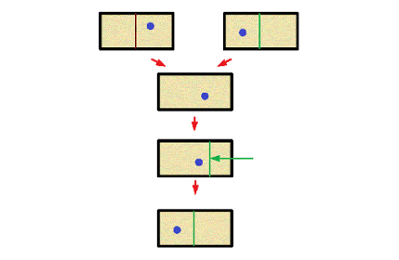
2.2. Landauer's principle
Erasure of information in an unreversible binary operation which sets a binary digid to zero in a computer memory regardless of whether it is initially 1 or 0. Observe that most computer operations, such as storing in memory some portion of bits uses eresures.

Fig. 2.2/1
Landauer limit
In 1961, physicist Rolf Landauer from IBM, argued that the erasure operation must release a certain minimum amount of heat, proportional to the ambient temperature. More precisely, he claimed that a minimum possible amount of energy required to erase one bit of information is
\[k \cdot T \cdot ln(2)\]
where \(k\) is Boltzmann constant (\(\approx 1.38 \cdot 10^{−23} J/K\)) and \(T\) is the temperature of the circuit in Kelvins degrees.
This is known as the Landauer limit.
Example
The Landauer limit for total erasure of 1 Tetrabyte byte disc in room temperature emitts at least \(2.5 \cdot 10^{−8}\) joules of energy. This is a very small account of energy - it may heat one gram of water for \(0.5 \cdot 10^{−8}\) degrees. On the other side contemporary devices will consume for this operation approximately \(6 \cdot 10^{4}\) joules of energy. We see that the ratio between energy consumption of current devices and the lower Landauer boud is of the order \(10^{13}\).
Experimental confirmation
In 2012 Eric Lutz at the University of Augsburg, Germany and his colleagues have found experimental proof confirming theoretical Landauers result. They present their experiments in Nature, 483, 187–189 (2012).
Eric Lutz explanation:
Erasing information compresses two states into one. It is this compression that leads to heat dissipation.
Converse results
In 1997, C. Jarzynski from Institute for Nuclear Theory, University of Washington, formulated an equation to define the amount of energy that could theoretically be converted from a unit of information (Nonequilibrium Equality for Free Energy Differences).
New Discovery Opens Door For Radical Reduction in Energy Consumed by Digital Devices
University of California, Berkeley researchers say they have made the first direct observation of a phenomenon known as "negative capacitance." They discovered a unique reaction of electrical charge to applied voltage in a ferroelectric material, which could lead to a significant reduction in the power consumed by transistors and the devices containing them.
In the negative capacitance phenomenon, when the applied voltage is increased, the charge goes down. "This property, if successfully integrated into transistors, could reduce the amount of power they consume by at least an order of magnitude, and perhaps much more," says Berkeley professor Asif Khan. He says the technology could lead to longer-lasting cellphone batteries and less energy-consumptive computers, and it could extend by decades the trend toward faster, smaller processors.
The research also provides a possible way overcome the Boltzmann Tyranny, which limits the size of ultra-small transistors because they cannot dissipate the heat they generate to avoid self-immolation.
In addition, negative capacitance could be used to develop high-density memory storage devices, super capacitors, coil-free oscillators and resonators, and for harvesting energy from the environment.
Exploiting the negative capacitance of ferroelectrics is one in a list of strategies for reducing the per-joule cost of storing a single bit of information, according to Berkeley professor Ramamoorthy Ramesh.